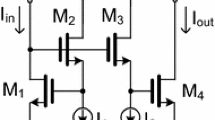Abstract
Two digitally programmable gain amplifiers based on current conveyors (CCIIs) are presented. The first digitally programmable gain amplifier consists of a CCII, an operational transconductance amplifier (OTA), and current mirrors. The second one is composed of current conveyor analogue switches (CCASs). Both proposed digitally programmable gain amplifiers do not need switches but they maintain the linear gain at any digital signal levels similar to the digitally programmable gain amplifier using switches; hence the proposed amplifiers are easier to realize, use narrower chip area, and consume lower power. The first proposed amplifier is verified by constructing the circuit using the CCII in an AD844 IC, the OTA in a CA3080 IC, and some bipolar current mirrors. The second proposed amplifier is verified by simulating the circuit using the parameters extracted from the layout (including parasitic capacitance) in the 0.25 μm MOS technology, the level 49 MOS model obtained through MOSIS is used. The results show that the operations of two proposed amplifiers are in accordance with the theories.











Similar content being viewed by others
References
Hsu, C. C., & Wu, J. T. (2003). A highly linear 125-MHz CMOS switched-resistor programmable-gain amplifier. IEEE Journal of Solid State Circuits, 38(10), 1663–1670.
Kim, T. W., & Kim, B. (2006). A 13-dB IIP3 improved low-power CMOS RF programmable gain amplifier using differential circuit transconductance linearization for various terrestrial mobile D-TV applications. IEEE Journal of Solid State Circuits, 41(4), 945–953.
Xiao, J., Mehr, I., & Silva-Martinez, J. (2007). A high dynamic range CMOS variable gain amplifier for mobile DTV tuner. IEEE Journal of Solid State Circuits, 42(2), 292–301.
Woo, B. B. (1980). Digitally programmable gain amplifiers with arbitrary range of gain values. Proceedings of the IEEE, 68(7), 934–936.
Roy, S. C. D. (1984). Digitally programmable gain amplifiers. IEEE Transactions on Instrumentation and Measurement, 33(4), 329–332.
Rathore, T. S. (1983). Digitally controlled amplifiers with fewer resistors and sensitivities. Electronic Letters, 19(6), 646–647.
Rathore, T. S., & Jain, L. C. (1995). Economical and accurate digitally programmable dual-polarity gain amplifier. Active and Passive Electronic Components, 18, 203–210.
Rijns, J. J. F. (1996). CMOS low distortion high frequency variable gain amplifier. IEEE J Solid State Circuits, 31(7), 1029–1034.
Elwan, H. O., & Ismail, M. (2000). Digitally programmable decibel-linear CMOS VGA for low-power mixed-signal applications. IEEE Transactions on Circuits and Systems II, 47(5), 388–398.
Sanz, M. T., Celma, S., & Calvo, B. (2007). Using MOS current dividers for linearization of programmable gain amplifiers. International Journal of Circuit Theory and Applications, 36(4), 397–408.
Calvo, B., Celma, S., & Sanz, M. T. (2003). High frequency digitally programmable gain amplifier. Electronics Letters, 39, 1095–1096.
Moore, S. (1991). Designing with Analogue Switches. New York: Marcel Dekker.
Premont, C., Abouchi, N., Grisel, R., & Chante, J. P. (1998). A current conveyor-based high-frequency analog switch. IEEE Transactions on Circuits and Systems I, 45, 298–300.
Monpapassorn, A. (2002). An analogue switch using a current conveyor. International Journal of Electronics, 89, 651–656.
Bruun, E. (1993). CMOS high speed, high precision current conveyor and current feedback amplifier structures. International Journal of Electronics, 74, 93–100.
Wang, Z. (1990). 2-MOSFET transistor with extremely low distortion for output reaching supply voltage. Electronics Letters, 26, 951–952.
Johns, D., & Martin, K. (1997). Analog integrated circuit design. New York: Wiley.
Intersil Corporation, CA3080 Data Sheet. http://www.intersil.com/data/fn/fn475.pdf.
Analog Devices, AD844 Data Sheet. http://www.analog.com/static/imported-files/data_sheets/AD844.pdf.
Prommee, P., Angkeaw, K., Somdunyakanok, M., & Dejhan, K. (2009). CMOS-based near zero-offset multiple inputs max–min circuits and its applications. Analog Integrated Circuits and Signal Processing, 61, 93–105.
Author information
Authors and Affiliations
Corresponding author
Rights and permissions
About this article
Cite this article
Angkeaw, K., Prommee, P. Two digitally programmable gain amplifiers based on current conveyors. Analog Integr Circ Sig Process 67, 253–260 (2011). https://doi.org/10.1007/s10470-010-9548-7
Received:
Revised:
Accepted:
Published:
Issue Date:
DOI: https://doi.org/10.1007/s10470-010-9548-7




